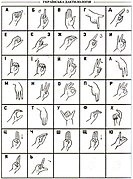- Ukrainian Manual Alphabet (UMA), post 2003. Differs from Soviet type of UMA in that it contains Ґ
- Soviet type of Ukrainian Manual Alphabet (UMA), used prior to 2003. Differs from the UMA used in independent Ukraine in that it lacks Ґ
External links
| Alphabets | |
|---|---|
| Types | |
| | This article about a sign language or related topic is a stub. You can help Wikipedia by expanding it. |
| | This article about a manual alphabet is a stub. You can help Wikipedia by expanding it. |

